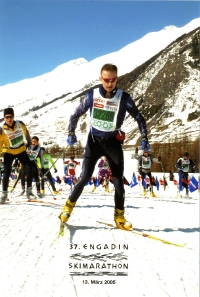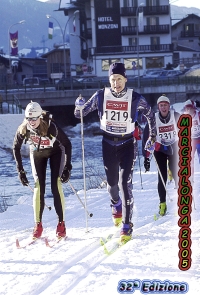 |
||||
|
|
Features - 16/2/7 The Ski Marathon season is now fully underway. Chris Richards - racing secretary of the London Region Nordic Ski Club - gives some tips on getting round. This article first appeared in the LRNSC club newsletter in February 2007. It’s been a patchy start to the snow season, although as I write there seems to be a change coming in the weather, so let’s hope the races all run as planned. Since there aren’t any events to write up since the last newsletter, I thought I would have a change and put in some practical tips for those doing a popular race for the first or second time. I would like you to benefit from the mistakes I have made in ignorance over the years. Go with other more experienced skiers There is a lot to know and if you go with others who have done it before it makes a huge difference to how well you perform, and enjoy the event. The Club always has a trip to at least one of the Loppetts. This year there will be a trip to the Bieg Piastow in Poland at the end of February and the Koenig Ludwig Lauf at the beginning. The German event is a very good choice for a first Loppett: the course is not too tough and it’s not as crowded as some races. If you do go it alone, here are some of the things to think about, apart from the skiing itself: Ski Preparation A good wax job will make a big difference to your enjoyment of the race, even if you are on waxless skis. Not everyone will agree with me here but I think there is a lot to be said for getting the local experts to do it for you. It might cost you £25 for a quality service but how much have you spent getting there? I often wax a pair of skis myself and get another pair done by the shop, then test them both out. More often than not it’s the shop pair that is selected. If doing it yourself, get the local wax tips but don’t get too worked up about it. The experts get it wrong sometimes and you have to be prepared to adjust at short notice, especially in a classic race. Allow plenty of time before you start to test your skis and remember, it will probably warm up during the race. Clothing Is very important, and not easy to get right. You have to be able to keep warm at the start standing around for a long time in the coldest part of the day, then avoid overheating in the flurry at the start, getting soaked with sweat, afterwards stay warm and comfortable for several hours, and not get chilled at the end. The answer lies in the layers, as everyone knows, and making use of the race support to take extra clothing for when you need it. It’s vital to stay warm at the start so hang on to an extra layer top and bottom as long as possible. Some races let you leave a bag where you stand, most require you to drop it in a lorry which might be some way from the start pen. If you have to abandon your outer layer, take a disposable T-shirt, bin bag or whatever you can find. Once the gun goes you will rapidly warm up, so open up a couple of zips just beforehand (you won’t have a chance after) During the race, monitor your thermal comfort and adjust your clothing to conditions. Hats make a big difference, take it off if you are hot and stick it in a pocket, you might need it later. At the end, don’t stand around in damp kit getting cold. Retrieve your bag straight away and change your underlayer (bliss!) and put on an extra layer, then go and chat to others. Staying upright Spills at the start are common. Injuries are rare but broken skis and poles are the usual result, and your weeks of preparation all come to nought, though you can sometimes borrow a replacement off the organisers. The trick is to ski “tight” at the start. Keep your skis and poles close to your body. It doesn’t produce the best style or glide but it avoids snagging other skiers, who may be all over the place. Be prepared to double pole a lot of the time at the start of a skate or classic race, with short rapid strokes. It’s worth practising that technique beforehand so it’s ready when you need it. When the race goes uphill, the chances are you will have to herringbone in a crowd, and there is always much snagging of each others’ skis and poles. If you are lucky the skiers will organise themselves into orderly lines and you join one and patiently shuffle up the hill, saving your energy for when there is more room. It’s rarely worth trying to overtake on a crowded hill, you will just be tripped. If it’s a free-for-all, ski tight again, keep your poles very close to your skis. If someone steps on to your ski or pole, be patient and wait for them to get off. If you try and pull free you risk losing a pole tip. Downhills need care. Loppett courses are not usually too technical but the track is often in poor condition after a few thousand skiers have passed. There will be inexperienced skiers around you who can fall in front of you. Watch ahead to see what other skiers ahead are doing, and keep a bit of room behind the skier in front so that you can take avoiding action if necessary. Remember if you decide to overtake a skier that they won’t know you are there and might ski across your line. It’s your responsibility to overtake safely. Food and Drink There is always plenty provided by the organisation but bear in mind that it might not agree with you. I’m not a fan of synthetic energy drinks so I always take a bottle of dilute fruit juice or weak black tea with honey. Some emergency rations such as an energy bar or dried fruit completes my personal supply. [Plus take care in very cold conditions - you'll need a lot more energy than in warm, sunny conditions - IB] Above all, enjoy it! A ski marathon is a serious test of fitness, technique and equipment, and there will be times when you will find it hard, but it should still be fun. Enjoy responding to the challenge and you will have a great time. Links As racing secretary of the LRNSC, Chris organises the club's series of rollerski races which take place throughout the summer:
|
||

